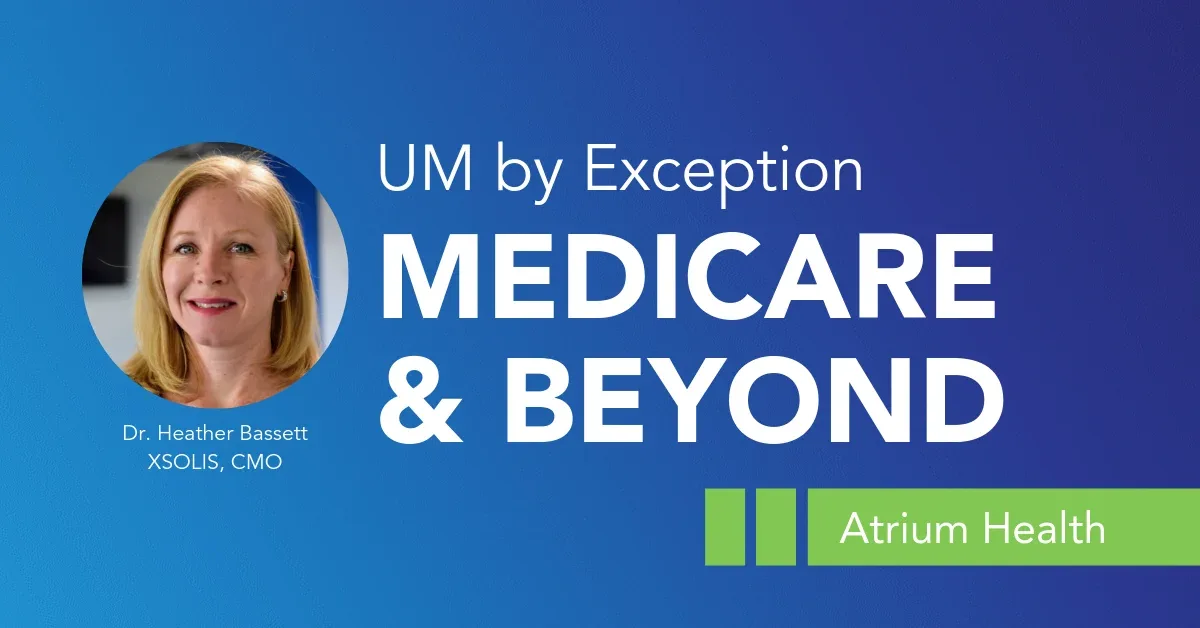Late last month I moderated a webinar with a panel of two industry leaders, Tonya Harrison representing Atrium Health and Sherri Ernst representing Covenant Health. In another post, I explore Covenant Health’s approach to payer relations, but today I want to focus on Atrium Health’s adoption of AI-driven UM by Exception for both commercial and government payers.
What is UM by Exception?
What Atrium is doing is quite simple: they’re using predictive analytics to automate an entire body of administrative legwork for case reviews across a subset of payers, allowing their staff to refocus their time towards what I’ll call “top of license” tasks. They use Xsolis’ Care Level Score™ (CLS), a real-time analysis of medical necessity, to stratify their patient population: any cases that meet a certain threshold of the Care Level Score are automatically determined inpatient, and only require an approximate 1-minute examination by the reviewing nurse before approval.
Their approach is not only new, it’s a completely different way to think about the process of utilization management. By decreasing the manual nature of UM, nurses are able to spend more time on complex cases, truly understand the patient and refocus their time in a patient-centric way.
It’s not only a patient-centric approach, it’s a colleague-centric one as well. When clinicians and nurses are able to use the clinical skills they’ve built across their careers rather than just checking boxes or handling administrative tasks, they are happier, more productive and better able to serve the needs of the patient and the organization.
Which payers can UM by Exception be used with?
Atrium’s UM by Exception approach extends across a growing subset of payers: Medicare, some Medicare Advantage plans that have EMR access, select commercial payers, and Medicaid. Other commercial payers have expressed interest in this approach as well and are working with Atrium to make it a reality.
Atrium started with Medicare, then engaged other payers with the process in a data-centered way. If you’re interested in adopting this approach with payers, the first thing you’ll need to do is work internally to analyze your payer trends: denials, approvals, timing, etc. When partnered with Xsolis, we provide you this analysis as well as offering you an analysis of your cases and claims based on their Care Level Score, helping your organization identify a CLS threshold that covers a significant number of cases with an extremely high level of accuracy on both final billed and paid status.
You’ll then need to work with your UM committee to start the conversation with payer representatives and incorporate XSOLIS into your UM plan. For Medicare cases, the process can be implemented easily and swiftly; for commercial payers, it’s a collaborative process. The value for the payer is clear: their staff is also enduring the same administrative burdens – calls, faxes, denials – and want to find a better way to partner with their providers for a seamless, frictionless approach to managing utilization and providing care for their members.
With the benefits that Atrium has seen from this approach, – around 17% of cases impacted by the smart review process and significant staff time rededicated towards true clinical work – it’s not a surprise that both payers and providers are taking a renewed look at their UM processes. As the the market continues to validate this approach, UM by Exception will be the new normal for utilization management.
If you’re interested in learning more about this approach, contact us and we’ll be able to offer you a product demonstration that’s customized to you and we can connect you with other leaders in the industry who have joined the movement towards smarter healthcare.
